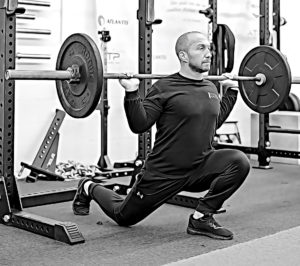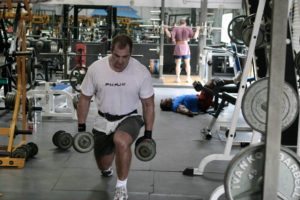
Don’t Forget Lunges!
Split squats were one of Charles R. Poliquin’s favorite exercises, but so was the concept of variety. So, whereas he frequently prescribed split squats in his workouts, occasionally he would include some lunges for variety. Here are a few of the pros and cons of this classic exercise.
To ensure we are on the same page, a lunge involves taking a step forward to assume a split position. With a split squat, you start from a split position. More weight can be used in a split squat because you don’t have to move, whereas with a lunge your stability is compromised because your entire center of mass is displaced forward. That’s an important distinction.
Both exercises strengthen the quads, glutes, hamstrings, adductors, and calves—along with muscles that stabilize the pelvis. However, the reduced stability of the lunge reduces the amount of weight that can be used, and because intensity is determined by resistance, split squats are superior for developing hypertrophy and mass. Yes, squats are King, but sometimes the lower back needs a break, and the upright stance of lunges and split squats enable you to work these muscles without overtraining the erector spinae muscles.
For resistance, at a low strength level, medicine balls (held across the chest) and sandbags can be used. Next would be dumbbells, kettlebells, and a barbell. Dumbbells and kettlebells are the most popular as holding the weights closer to the floor (than a barbell) increases stability, making them ideal for walking lunges.
 Dumbbells increase stability, which makes them ideal for walking lunges. When performing this exercise, be certain to avoid obstacles, such as loose dumbbells and people who collapsed on the floor after doing squats as shown in this photo by Miloš Šarčev.
Dumbbells increase stability, which makes them ideal for walking lunges. When performing this exercise, be certain to avoid obstacles, such as loose dumbbells and people who collapsed on the floor after doing squats as shown in this photo by Miloš Šarčev.
The Strength Sensei believed that for maximum results, especially for those who want to focus on the gluteus maximus, a full range of motion was critical. And yes, a full range of motion means the knees must move in front of the toes. One problem – many individuals, especially men, don’t have the flexibility in their ankles to achieve this level of dorsiflexion (i.e., pulling the ball of foot towards the shins). Solutions include investing in weightlifting shoes, which have an elevated heel, or placing a heel lift in your shoes. Another is to lunge to a slightly elevated platform (such as an aerobic step).
A raised platform will compensate for restricted ankle mobility and is ideal for those with ankle and knee instability because there is less stress on the front leg. As a bonus, performing this variation of the lunge will help increase ankle mobility, so that eventually you will be able to perform conventional lunges through a full range of motion.
For advanced individuals, and athletes who want to include a plyometric effect to improve performance, a lunge can be performed while standing on a low platform. You step down, then immediately explode upward. Often, only bodyweight is needed to achieve optimal overload as the drop increases resistance and because the elevated platform places more stress on the front leg.
Finally, don’t stop your education about lunges with this article. There are many variations, each emphasizing different results. For example, although the split squat enables you to use more weight than a lunge, a reverse lunge (stepping backward) enables you to use more weight than a forward lunge because more resistance is placed on the non-moving leg. This variation also requires less knee and ankle stability.
Although not as popular as split squats, lunges have many benefits and deserve a place in your exercise toolbox. (TSS)
